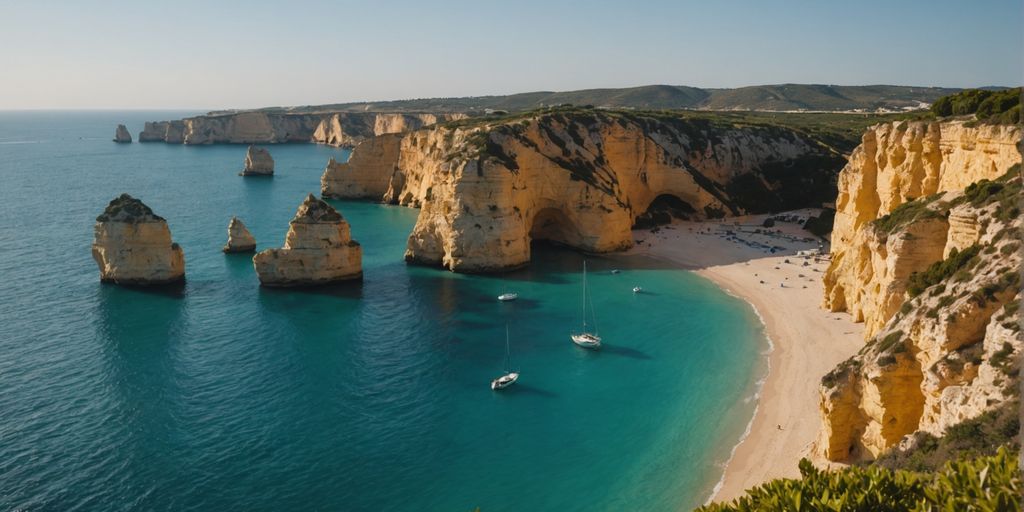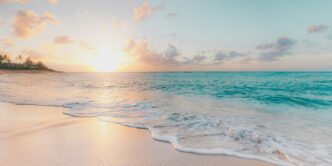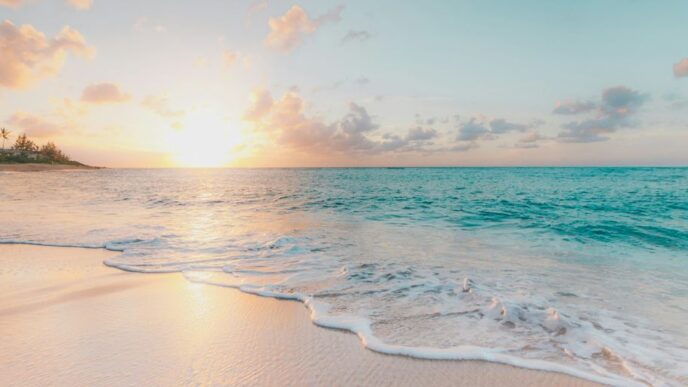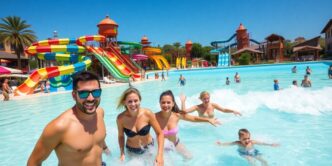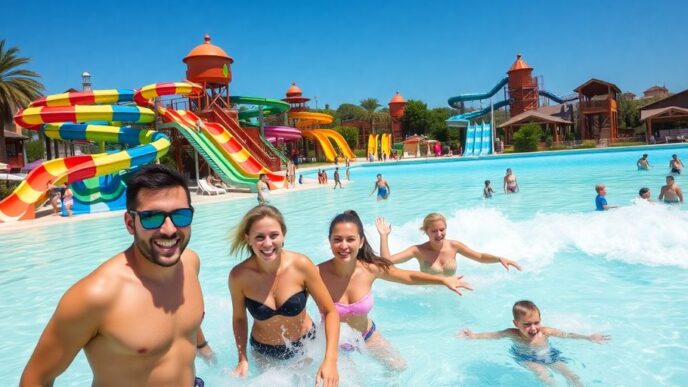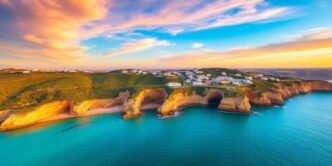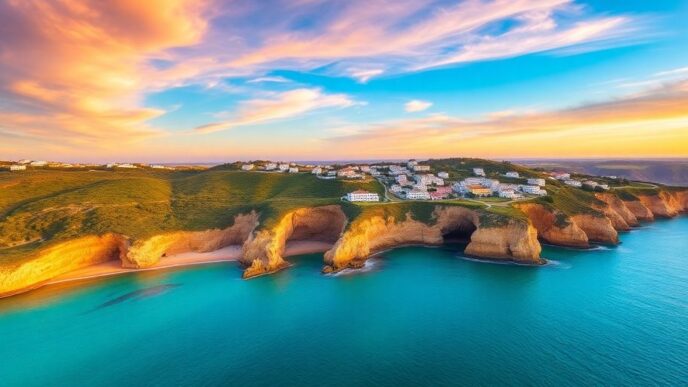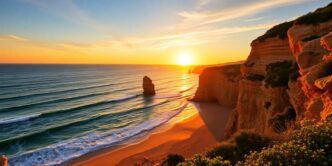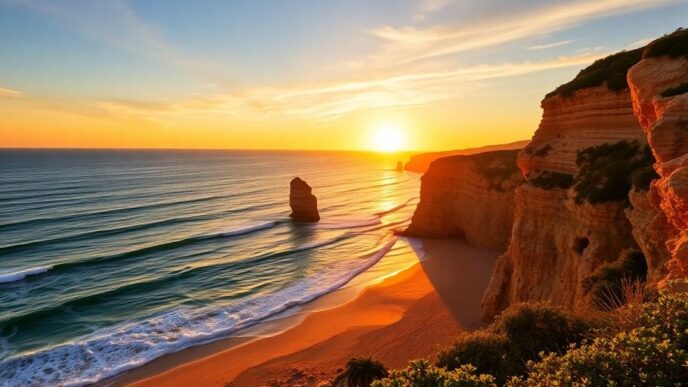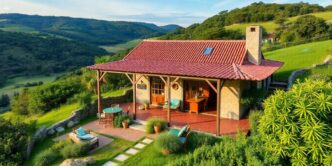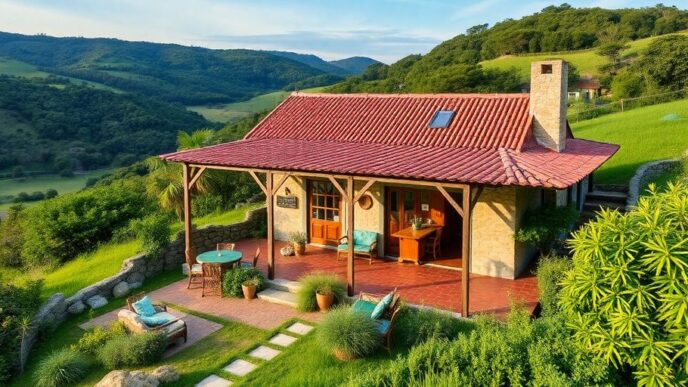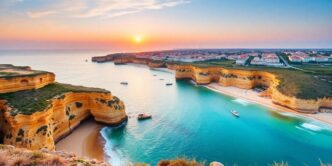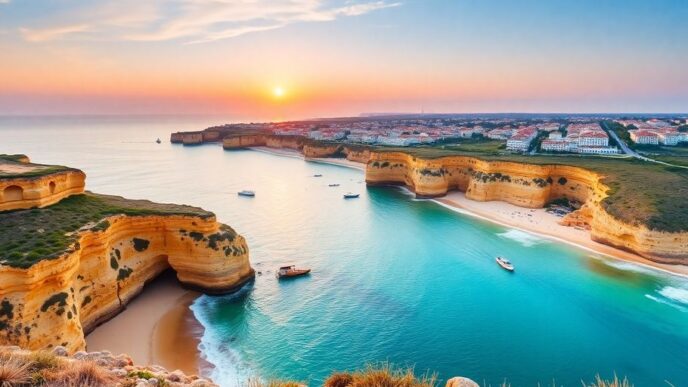Faro
Faro is the capital city of the Algarve and the main entry point for visitors flying in. Despite this, many tourists skip it for other resorts. Just 6 km from the airport, Faro’s historic center is a must-see. The Old Town is a walled city with cobblestone streets, quaint shops, and charming cafes. The beautiful cathedral offers a magnificent view over the Ria Formosa. Don’t miss the Roman theater and baths that highlight the area’s ancient past. The scenic Ria Formosa lagoon nearby is perfect for boat trips and stunning sunsets. Faro is a blend of rich history, natural beauty, and a vibrant atmosphere.
Lagos
Lagos is one of the liveliest towns in the western Algarve. It’s also rich in history. Prince Henry the Navigator started Portugal’s Age of Discovery from here in the 15th century. His vision and the bravery of explorers put Portugal on the world map. Lagos is proud of its seafaring heritage.
The town is best known for its dining and nightlife. There’s a lot to see, starting with historic architecture like baroque churches, a 17th-century fortress, and old town walls. The nearby beaches, especially Praia de Dona Ana, are some of the Algarve’s prettiest.
Lagos has kept its authenticity. Wander through the alleys of its historic center and soak in the atmosphere. Don’t miss the Mercado Municipal, the city market.
Lagos is small, so you can see the main attractions in a few hours. Be sure to visit the stunning coastal areas nearby. Must-see spots include Ponta da Piedade and scenic beaches like Praia do Camilo and Praia Dona Ana.
When the sun sets, Lagos becomes even more charming. Restaurants fill with diners enjoying fresh seafood. The night continues at microbrew bars and cocktail lounges in the narrow lanes. Check out the rooftop terrace of Bon Vivant or join the party at the dance club below.
Sagres
Sagres is a small, quiet village in the Algarve. It’s perfect for those who love the sea. The best surf in the Algarve can be found here. The headland faces three directions, so there’s always a beach with the perfect swell. You can rent surfboards or take lessons at the many surf schools. If surfing isn’t your thing, try a dolphin-watching cruise. You might spot some leaping cetaceans!
For history buffs, the centuries-old Fortaleza de Sagres is a must-see. Walk to the edge of the cliffs and watch the waves crash below. The views are breathtaking. Don’t miss the Cabo de São Vicente lighthouse, the southwesternmost point of continental Europe. It’s a spot that feels like the edge of the world.
When you’re ready for some action, head to Rua Comandante Matoso. This main street has lively terrace bars and restaurants. It’s the perfect place to unwind after a day of exploring.
Tavira
Tavira is one of the Algarve’s prettiest towns. It’s near the coast in the eastern Algarve. The town sits on both sides of the broad River Gilão. Tavira has a rich history shaped by the Romans and Moors. You can still see a castle from the Moorish times.
The old town is compact and very walkable. If you’re short on time, try a tuk-tuk tour for a quick intro to the main landmarks. Plan at least 2-3 hours to explore the town. Don’t miss the pristine beaches on Ilha de Tavira. Ferries leave from the quay, making it easy to visit.
For a unique experience, join a sightseeing cruise along the Ria Formosa. This waterway is part of a protected natural park. The coastline near Tavira is also part of this park. The beaches here have white-sand dunes and are flat, unlike other popular spots in the Algarve.
Albufeira
Albufeira is a top pick for many Algarve holidaymakers. Its central spot on the southern coast of Portugal makes it super accessible. Tourists from all over Europe and beyond love it here.
This place is perfect for sightseeing. You can find the biggest variety of excursions and tours in the Algarve. Whether you want scenic coastlines, long sandy beaches, or a charming old town, Albufeira has it all.
There are countless excellent restaurants, cafes, and busy bars for all tastes and budgets. Plus, there are lots of fun activities for both young and old. Even in the low season, Albufeira stays lively.
The resort’s neon-lit streets are full of hotels, cafés, restaurants, and entertainment venues. Albufeira is often the preferred choice for families. The leisure facilities here are top-notch and appeal to everyone.
Set on sandstone cliffs above a wide sandy bay, Albufeira was once a quiet fishing village. It had whitewashed cottages, a chapel, and a church. The Romans even built a castle here, later strengthened by the Moors.
Portimão
Portimão is the Algarve’s second largest city, sitting pretty by the River Arade. It’s a lively cultural hub with an award-winning museum and a famous theater complex. The city is also a popular stop for luxury cruise ships heading to the Mediterranean.
Portimão has a rich history, once known for its bustling cannery industry. Today, it’s a favorite for tourists who love urban settings but still want to be close to the beach.
Don’t miss the Museu de Portimão. This award-winning museum is in an old cannery building and tells the story of the town’s fishing and canning past. You’ll also find rare artifacts from pre-historic, Roman, and Islamic times.
Before you leave, visit Santa Catarina Fortress at the mouth of the Arade River. The view over Praia da Rocha, one of Portugal’s most famous beaches, is simply stunning.
Silves
Silves is a charming town where you can experience the more authentic side of the Algarve. Walk around its cobbled streets, have lunch at one of the local restaurants, and – if you have some time and depending on the season – you can also visit some orange orchards or vineyards nearby.
Silves is worth exploring at leisure. Downhill from the fortress is the Sé (cathedral), built between 1242 and 1577 on the site of Xelb’s Grand Mosque. Opposite is the 16th-century Igreja da Misericórdia, replete with a fine Manueline side door.
The town itself is delightful, especially the area along the riverfront, which is lined with a small market and some excellent restaurants. Cruise boats from Portimão tie up here near the old bridge.
Ria Formosa Natural Park
Ria Formosa Natural Park stretches over 60 kilometers of coastline in the Algarve. It’s a mix of wetlands, lagoons, dunes, and marshes. This park is a haven for over 200 bird species, including flamingos and terns. In winter, it becomes a sanctuary for waterfowl.
You can enjoy activities like birdwatching, kayaking, swimming, and fishing. The park offers stunning views of the Atlantic Ocean and shelters rare local flora and fauna. The park’s team closely monitors these species.
Boat tours are a unique way to explore the park’s canals and lagoons. These tours let you experience the Algarve’s Ria Formosa through diverse landscapes, wildlife, and culinary delights. The park’s natural beauty and cultural heritage, including Roman ruins, make it a must-visit in Portugal!
Serra de Monchique
Serra de Monchique offers a refreshing change from the Algarve’s beach scene. This rolling mountain range adds a dramatic touch to the western countryside. The slopes are covered with chestnut and eucalyptus trees, creating a lush habitat for wildlife.
For the best view, head to Mount Foia. At 902 meters, it’s the highest peak in the Algarve. The view from the top is simply amazing. On hot summer days, it’s cooler up there, making it a perfect escape.
Don’t miss the historic town of Monchique, just 8 km away. Wander through its charming streets and visit the 17th-century Nossa Senhora do Desterro Convent. Also, check out Caldas de Monchique, a thermal village dating back to Roman times.
Alvor
Alvor is one of the oldest and most beautiful towns in Algarve. It’s a place you won’t want to miss! The town has a rich history tied to fishing, but today, tourism is the main industry.
Alvor Boardwalk
Take a stroll on the Alvor Boardwalk. It’s the biggest walkway in Algarve, stretching for 5 km. Perfect for a relaxing walk.
Praia dos Três Irmãos
Visit Praia dos Três Irmãos. This beach is stunning with its unique rock formations. Great for a day out in the sun.
Praia de Alvor
Another must-visit is Praia de Alvor. It’s a beautiful beach where you can relax and enjoy the warm weather.
Ria de Alvor
Don’t miss the Ria de Alvor river mouth. It’s a great spot for bird watching and enjoying nature.
Frequently Asked Questions
What is the Algarve known for?
The Algarve is famous for its beautiful beaches, charming fishing villages, and stunning cliffs. It’s also known for its historical towns and delicious local food.
Is the Algarve good for families?
Yes, the Algarve is great for families. There are many family-friendly beaches, water parks, and activities to enjoy together.
When is the best time to visit the Algarve?
The best time to visit the Algarve is from May to September when the weather is warm and sunny. However, it can get crowded during the summer months.
What can I do in Faro?
In Faro, you can explore the old town, visit the cathedral, and take a boat trip to the nearby islands. There’s also a lot of great food to try.
Are there any hiking trails in the Algarve?
Yes, there are many hiking trails in the Algarve. The Rota Vicentina and the “7 Hanging Valleys” Walk are popular choices with beautiful views.
Can I visit historical sites in the Algarve?
Absolutely! You can visit historical towns like Silves with its ancient castle, and Tavira with its old churches and Roman bridge.
Is it easy to get around the Algarve?
Yes, it’s easy to get around the Algarve. You can rent a car, use public transportation, or join guided tours to explore the region.
What kind of food can I try in the Algarve?
In the Algarve, you can try fresh seafood, traditional Portuguese dishes, and delicious pastries. Don’t miss out on trying the local wines too.

